Cannabidiol: Difference between revisions
| Line 138: | Line 138: | ||
===Natural sources=== |
===Natural sources=== |
||
Cannabidiol is readily extracted from hemp and different strains of marijuana. Hemp crops have largely been valued for the fiber and seeds and used to manufacture rope, canvas, paper, oils, biodegradable plastics, food products and clothing. New emphasis around the medicinal potential of CBD has invigorated interest in the cultivation of hemp. Marijuana and hemp, while both of the cannabis family, have [[phytochemical]] (cannabinoid) components that are nearly the opposite of each other. Most marijuana strains contain a high level of THC and a low level of CBD, while hemp has high levels of CBD with minimal traces of THC. |
|||
Selective breeding by growers in the USA dramatically lowered the CBD content of cannabis; their customers preferred varietals that were more mind-altering due to a higher THC, lower CBD content.<ref name=autogenerated1>{{cite news| url=http://articles.latimes.com/2012/sep/13/local/la-me-customized-marijuana-20120914 | work=Los Angeles Times | first=Lee | last=Romney | title=On the frontier of medical pot to treat boy's epilepsy | date=13 September 2012}}</ref> To meet the demands of medical cannabis patients, growers are currently developing more CBD-rich strains.<ref>{{cite news| url=http://www.telegraph.co.uk/health/8080247/The-rise-of-high-CBD-marijuana-Cannabis.html | location=London | work=The Daily Telegraph | first1=Alastair | last1=Good | title=Growing marijuana that won't get you high | date=26 October 2010}}</ref> |
|||
While the recreational practice of smoking marijuana was amplified in youthful sub-cultures in the U.S. from the 1970's-forward, marijuana and hemp plants have a legacy dating back centuries. Going into the years 2000 and forward, interest in cultivating medical marijuana has increased interest in the production of greater varieties of industrial, recreational and therapeutic cannabis crops. To produce these varieties, cannabis growers cross-bred strains to create a wider range in the makeup of cannabinoid combinations. Strains were also sought after on the "street market" that were produced by growers who lowered the CBD content of cannabis in order to boost the psychoactive effect of it's THC component.<ref name=autogenerated1>{{cite news| url=http://articles.latimes.com/2012/sep/13/local/la-me-customized-marijuana-20120914 | work=Los Angeles Times | first=Lee | last=Romney | title=On the frontier of medical pot to treat boy's epilepsy | date=13 September 2012}}</ref> |
|||
| ⚫ | Several industrial |
||
But gradually, discoveries of numerous "non-high-producing" cannabinoids such as cannabidiol (CBD), cannabigerol (CBG), cannabichromene (CBC), tetrahydrocannabivarin (THCV), cannabidivarin (CBDV) as well as cannabinoid acids such as tetrahydrocannabinolic acid (THCA) and cannabidiolic acid (CBDA) have been studied<ref>{{cite journal |vauthors=Izzo AA, Borrelli F, Capasso R, Di Marzo V, Mechoulam R |title=Non-psychotropic plant cannabinoids: new therapeutic opportunities from an ancient herb |journal=Trends Pharmacol. Sci. |volume=30 |issue=10 |pages=515–27 |year=2009 |pmid=19729208 |doi=10.1016/j.tips.2009.07.006 |url=}}</ref> and regarded as having potential health benefits. |
|||
Entering into the medical cannabis industry in Colorado, the Stanley Brothers began breeding high-CBD cannabis strains in 2009. They sought benefits specifically for patients who didn't want THC-produced psycho-activity. The Stanley's CBD project became known as the Charlotte's Web breeding project leading to 5-year-old Charlotte Figi's dramatic success in her battle with intractable epilepsy. |
|||
This story gained national media attention and thus more growers are increasingly developing more CBD-rich strains.<ref>{{cite news| url=http://www.telegraph.co.uk/health/8080247/The-rise-of-high-CBD-marijuana-Cannabis.html | location=London | work=The Daily Telegraph | first1=Alastair | last1=Good | title=Growing marijuana that won't get you high | date=26 October 2010}}</ref> Today, even though the flowers (buds) of the Charlotte's Web breed would normally be associated with marijuana, because of the low THC content, it is cultivated and certified as hemp<ref>http://www.cwhemp.com/coa/A00136.pdf</ref> in Colorado and marketed as a dietary supplement. |
|||
Companies such as Medical Marijuana, Inc., makers of Real Scientific Hemp Oil (RSHO), are emerging in other states such as California. As reported by ABC 10 News, the all-natural, non-GMO hemp-based cannabidiol (CBD) oil product is now approved by the government of Brazil for import with approved in-country documentation, making Brazil the largest single client for the San Diego-based company.<ref>https://globenewswire.com/news-release/2015/10/27/780389/0/en/ABC-10-News-Brazil-Government-Now-Medical-Marijuana-Inc-s-Largest-International-Client-With-Cannabidiol-CBD-Hemp-Oil-Export-Including-RSHO.html</ref> |
|||
Multiple states in the U.S. provide for lawful cultivation of hemp. Statutes provide permission to cultivate commonly for the purposes of academic or agricultural research programs within state institutions of higher education. States such as Maine, Maryland, Montana, North Dakota, South Carolina, and Oregon authorize industrial hemp production and possession, and commerce in industrial hemp commodities and products.<ref>http://www.ncsl.org/research/agriculture-and-rural-development/state-industrial-hemp-statutes.aspx</ref> |
|||
| ⚫ | Several industrial hemp varieties can be legally cultivated in [[western Europe]]. A variety such as "Fedora 17" has a cannabinoid profile consistently around 1% cannabidiol (CBD) with [[tetrahydrocannabinol|THC]] less than 0.1%.<ref>{{cite journal | last1 = Fournier | first1 = G. | last2 = Beherec | first2 = O. | last3 = Bertucelli | first3 = S. | title = Intérêt du rapport Δ-9-THC / CBD dans le contrôle des cultures de chanvre industriel | journal = Annales de Toxicologie Analytique | volume = 15 | issue = 4 | pages = 250–259 | year = 2003 | doi = 10.1051/ata/2003003 }}</ref> |
||
===Legal status=== |
===Legal status=== |
||
Revision as of 22:16, 6 July 2016
 | |
 | |
| Clinical data | |
|---|---|
| Trade names | Epidiolex |
| AHFS/Drugs.com | International Drug Names |
| ATC code |
|
| Legal status | |
| Legal status |
|
| Pharmacokinetic data | |
| Bioavailability | 13-19% (oral),[2] 11-45% (mean 31%; inhaled)[3] |
| Elimination half-life | 9 h[2] |
| Identifiers | |
| |
| CAS Number | |
| PubChem CID | |
| IUPHAR/BPS | |
| ChemSpider | |
| UNII | |
| CompTox Dashboard (EPA) | |
| ECHA InfoCard | 100.215.986 |
| Chemical and physical data | |
| Formula | C21H30O2 |
| Molar mass | 314.4636 g·mol−1 |
| 3D model (JSmol) | |
| Melting point | 66 °C (151 °F) |
| Boiling point | 180 °C (356 °F) (range: 160–180 °C)[4] |
| |
| |
| (verify) | |
| Part of a series on |
| Cannabis |
|---|
 |
Cannabidiol (CBD) is one of at least 113 active cannabinoids identified in cannabis.[5][6] It is a major phytocannabinoid, accounting for up to 40% of the plant's extract.[7] CBD is considered to have a wide scope of potential medical applications - due to clinical reports showing the lack of side effects, particularly a lack of psychoactivity (as is typically associated with ∆9-THC), and non-interference with several psychomotor learning and psychological functions.
Research

Epilepsy
Dravet syndrome is a rare form of epilepsy that is difficult to treat. It is a catastrophic form of intractable epilepsy that begins in infancy. Initial seizures are most often prolonged events and in the second year of life other seizure types begin to emerge.[8] A number of high profile and anecdotal reports have sparked interest in treatment of Dravet syndrome with cannabidiol.[9]
Some cannabis/hemp extract preparations containing CBD are marketed as dietary supplements and claim efficacy against Dravet Syndrome. One such preparation is marketed under the tradename Charlotte's Web Hemp Extract.[10][11] Blended/suspended in oil, the supplement contains 0.3% THC[12] (see Legal status below, classified as hemp).
GW Pharmaceuticals is seeking FDA approval to market a liquid formulation of pure plant-derived CBD, under the trade name Epidiolex (containing 99% cannabidiol and less than 0.10% Δ9-THC) as a treatment for Dravet syndrome. Epidiolex was granted fast-track status and is in late stage trials following positive early results from the drug.[9][13][14][15][16]
A 2014 review stated that cannabidiol has been claimed, anecdotally, to be of benefit in helping people with epilepsy. Information in the review stated that there is no established mechanism of action and the lack of high-quality evidence in this area precluded conclusions being drawn.[17]
A newer 2016 review in The New England Journal of Medicine states that since 2013, data has been collected on patients with severe epilepsy (Dravet’s syndrome and the Lennox–Gastaut syndrome). Among 137 patients treated with Epidiolex (qualifies chemically as hemp, see Legal status below), the median reduction in the number of seizures was 54%.[18]
Schizophrenia
A 2016 Leweke et al. review stated that THC-dominant cannabis carries the highest risk for psychotic disorders and an increased risk of psychosis. In contrast, cannabidiol (CBD) produced the reduction of psychotic symptoms due to a significant increase of anandamide levels. This supports the hypothesis that cannabidiol exerts its antipsychotic properties by a moderate inhibition of the FAAH enzyme (which is known to break down anandamide). Data on the antipsychotic effects of cannabidiol in schizophrenia is still limited, but with promising initial results and a lack of side-effects. With current trials limited to 6 weeks of treatment at maximum, information on long-term efficacy and tolerability is not available yet.[19]
CBD clearly reversed synthetic THC (Nabilone induced) psychoactive effects. CBD had opposite effects to THC on activation of the striatum, prefrontal cortex and medial temporal cortex.[20]
Safety
CBD safety in humans has been studied in multiple small studies, suggesting that it is well tolerated at doses of up to 1500 mg/day (p.o.) or 30 mg (i.v.).[21]
Pharmacodynamics
Cannabidiol has a very low affinity for CB1 and CB2 receptors but acts as an indirect antagonist of their agonists.[22][23] While one would assume that this would cause cannabidiol to reduce the effects of THC, it may potentiate THC's effects by increasing CB1 receptor density or through another CB1-related mechanism.[24] It may also extend the duration of the effects of THC via inhibition of the cytochrome P-450-3A and 2C enzymes.[25]
Recently, it was found to be an antagonist at the putative new cannabinoid receptor, GPR55, a GPCR expressed in the caudate nucleus and putamen.[26] Cannabidiol has also been shown to act as a 5-HT1A receptor partial agonist,[27] an action which may be involved in its antidepressant,[28][29] anxiolytic,[29][30] and neuroprotective[31][32] effects. Cannabidiol is an allosteric modulator of μ and δ-opioid receptors.[33] Cannabidiol's pharmacological effects have also been attributed to PPAR-γ receptor agonism and intracellular calcium release.[7]
Research suggests that CBD may exert some of its pharmacological action through its inhibition of FAAH, which may in turn increase the levels of endocannabinoids, such as anandamide, produced by the body.[7] It has also been speculated that some of the metabolites of CBD have pharmacological effects that contribute to the biological activity of CBD.[34]
Pharmacokinetic interactions
There is some preclinical evidence to suggest that cannabidiol may reduce THC clearance, modestly increasing THC's plasma concentrations resulting in a greater amount of THC available to receptors, increasing the effect of THC in a dose-dependent manner.[35][36] Despite this, the available evidence in humans suggests no significant effect of CBD on THC plasma levels.[37]
Multiple studies have shown that the purported negative cognitive side effects caused by THC can be mitigated by regular CBD consumption.[38] These findings bolster the theorized pharmacokinetic interactions that cannabidiol reduces THC clearance.
Pharmaceutical preparations
Nabiximols (USAN, trade name Sativex) is an aerosolized mist for oral administration containing a near 1:1 ratio of CBD and THC. The drug was approved by Canadian authorities in 2005 to alleviate pain associated with multiple sclerosis.[39][40][41] Epidiolex, a drug with cannabidiol as its active pharmaceutical ingredient, received orphan drug status in the United States for treatment of Dravet syndrome in July 2015.[42]
Epidiolex is an oil formulation of CBD extracted from the cannabis plant undergoing clinical trials for refractory epilepsy syndromes.[43]
Chemistry
Cannabidiol is insoluble in water but soluble in organic solvents such as pentane. At room temperature, it is a colorless crystalline solid.[44] In strongly basic media and the presence of air, it is oxidized to a quinone.[45] Under acidic conditions it cyclizes to THC.[46] The synthesis of cannabidiol has been accomplished by several research groups.[47][48][49]
Biosynthesis
Cannabis produces CBD-carboxylic acid through the same metabolic pathway as THC, until the last step, where CBDA synthase performs catalysis instead of THCA synthase.[50]

Isomerism
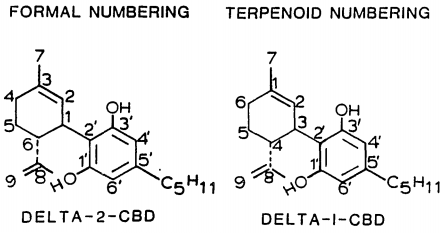
| 7 double bond isomers and their 30 stereoisomers | ||||||||
|---|---|---|---|---|---|---|---|---|
| Formal numbering | Terpenoid numbering | Number of stereoisomers | Natural occurrence | Convention on Psychotropic Substances Schedule | Structure | |||
| Short name | Chiral centers | Full name | Short name | Chiral centers | ||||
| Δ5-cannabidiol | 1 and 3 | 2-(6-isopropenyl-3-methyl-5-cyclohexen-1-yl)-5-pentyl-1,3-benzenediol | Δ4-cannabidiol | 1 and 3 | 4 | No | unscheduled | 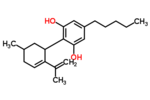
|
| Δ4-cannabidiol | 1, 3 and 6 | 2-(6-isopropenyl-3-methyl-4-cyclohexen-1-yl)-5-pentyl-1,3-benzenediol | Δ5-cannabidiol | 1, 3 and 4 | 8 | No | unscheduled | 
|
| Δ3-cannabidiol | 1 and 6 | 2-(6-isopropenyl-3-methyl-3-cyclohexen-1-yl)-5-pentyl-1,3-benzenediol | Δ6-cannabidiol | 3 and 4 | 4 | ? | unscheduled | 
|
| Δ3,7-cannabidiol | 1 and 6 | 2-(6-isopropenyl-3-methylenecyclohex-1-yl)-5-pentyl-1,3-benzenediol | Δ1,7-cannabidiol | 3 and 4 | 4 | No | unscheduled | 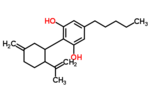
|
| Δ2-cannabidiol | 1 and 6 | 2-(6-isopropenyl-3-methyl-2-cyclohexen-1-yl)-5-pentyl-1,3-benzenediol | Δ1-cannabidiol | 3 and 4 | 4 | Yes | unscheduled | 
|
| Δ1-cannabidiol | 3 and 6 | 2-(6-isopropenyl-3-methyl-1-cyclohexen-1-yl)-5-pentyl-1,3-benzenediol | Δ2-cannabidiol | 1 and 4 | 4 | No | unscheduled | 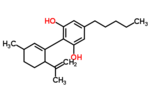
|
| Δ6-cannabidiol | 3 | 2-(6-isopropenyl-3-methyl-6-cyclohexen-1-yl)-5-pentyl-1,3-benzenediol | Δ3-cannabidiol | 1 | 2 | No | unscheduled | 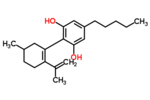
|
See also: Tetrahydrocannabinol#Isomerism, Abnormal cannabidiol.
Society and culture
Natural sources
Cannabidiol is readily extracted from hemp and different strains of marijuana. Hemp crops have largely been valued for the fiber and seeds and used to manufacture rope, canvas, paper, oils, biodegradable plastics, food products and clothing. New emphasis around the medicinal potential of CBD has invigorated interest in the cultivation of hemp. Marijuana and hemp, while both of the cannabis family, have phytochemical (cannabinoid) components that are nearly the opposite of each other. Most marijuana strains contain a high level of THC and a low level of CBD, while hemp has high levels of CBD with minimal traces of THC.
While the recreational practice of smoking marijuana was amplified in youthful sub-cultures in the U.S. from the 1970's-forward, marijuana and hemp plants have a legacy dating back centuries. Going into the years 2000 and forward, interest in cultivating medical marijuana has increased interest in the production of greater varieties of industrial, recreational and therapeutic cannabis crops. To produce these varieties, cannabis growers cross-bred strains to create a wider range in the makeup of cannabinoid combinations. Strains were also sought after on the "street market" that were produced by growers who lowered the CBD content of cannabis in order to boost the psychoactive effect of it's THC component.[51]
But gradually, discoveries of numerous "non-high-producing" cannabinoids such as cannabidiol (CBD), cannabigerol (CBG), cannabichromene (CBC), tetrahydrocannabivarin (THCV), cannabidivarin (CBDV) as well as cannabinoid acids such as tetrahydrocannabinolic acid (THCA) and cannabidiolic acid (CBDA) have been studied[52] and regarded as having potential health benefits.
Entering into the medical cannabis industry in Colorado, the Stanley Brothers began breeding high-CBD cannabis strains in 2009. They sought benefits specifically for patients who didn't want THC-produced psycho-activity. The Stanley's CBD project became known as the Charlotte's Web breeding project leading to 5-year-old Charlotte Figi's dramatic success in her battle with intractable epilepsy.
This story gained national media attention and thus more growers are increasingly developing more CBD-rich strains.[53] Today, even though the flowers (buds) of the Charlotte's Web breed would normally be associated with marijuana, because of the low THC content, it is cultivated and certified as hemp[54] in Colorado and marketed as a dietary supplement.
Companies such as Medical Marijuana, Inc., makers of Real Scientific Hemp Oil (RSHO), are emerging in other states such as California. As reported by ABC 10 News, the all-natural, non-GMO hemp-based cannabidiol (CBD) oil product is now approved by the government of Brazil for import with approved in-country documentation, making Brazil the largest single client for the San Diego-based company.[55]
Multiple states in the U.S. provide for lawful cultivation of hemp. Statutes provide permission to cultivate commonly for the purposes of academic or agricultural research programs within state institutions of higher education. States such as Maine, Maryland, Montana, North Dakota, South Carolina, and Oregon authorize industrial hemp production and possession, and commerce in industrial hemp commodities and products.[56]
Several industrial hemp varieties can be legally cultivated in western Europe. A variety such as "Fedora 17" has a cannabinoid profile consistently around 1% cannabidiol (CBD) with THC less than 0.1%.[57]
Legal status
Cannabidiol is not scheduled by the Convention on Psychotropic Substances. CBD does not cause the "high" associated with the ∆9-THC in marijuana. As the legal landscape and understanding about the differences in medical cannabinoids unfolds, it will be increasingly important to distinguish “medical marijuana” (with noted varying degrees of psychotropic effects and deficits in executive function) - from “medical CBD” (in which the high CBD and low THC content may mitigate psychosis).[58][59][60]
Various breeds/strains of "medical marijuana" are found to have a significant variety in the ratios of CBD-to-THC and are known to contain other non-psychotropic cannabinoids.[61][62] However it is only the amount of ∆9-THC that chemically gives a legal determination as to whether the plant material(s) used for the purposes of extracting CBD are considered hemp, or considered marijuana.
Any psychoactive marijuana, regardless of its CBD content, is derived from the flower (or bud) of the genus cannabis. Non-psychoactive hemp (also commonly-termed industrial hemp), regardless of its CBD content, is any part of the genus cannabis plant, whether growing or not, containing a ∆-9 tetrahydrocannabinol concentration of no more than three-tenths of one percent (0.3%) on a dry weight basis. Certain standards are required for the legal growth and production of hemp. The Colorado Industrial Hemp Program registers growers of industrial hemp and samples crops to verify that the THC concentration does not exceed 0.3% on dry weight basis.[63]
The United States Drug Enforcement Administration, the DEA, recently eased some of the regulatory requirements for those who are conducting FDA-approved clinical trials on cannabidiol (CBD).[64]
Australia
Prescription Medicine (Schedule 4) for therapeutic use containing 2 per cent (2.0%) or less of other cannabinoids commonly found in cannabis (such as ∆9-THC).[65]
Canada
Cannabidiol is a Schedule II drug in Canada. Prescription medication.[66]
UK
Cannabidiol, in an oral-mucosal spray formulation combined with delta-9-tetrahydrocannabinol, is a prescription product available for relief of severe spasticity due to multiple sclerosis (where other anti-spasmodics have not been effective).[67]
EU
Cannabidiol is listed in EU Cosmetics Ingredient Database.[68]
References
- ^ DEA News Release, DEA Eases Requirements for FDA Approved Clinical Trials on Cannabidiol (Dec. 23, 2015) ("CBD is a Schedule I controlled substance as defined under the CSA."), http://www.dea.gov/divisions/hq/2015/hq122315.shtml; Joseph T. Rannazzisi Deputy Assistant Administrator Drug Enforcement Administration Before the Caucus on International Narcotics Control, United States Senate, at 2 (June 24, 2015) (CBD is a Schedule I drug.); see also Frank Robison, Elvira Strehle-Henson, Cannabis Laws and Research at Colorado Institutions of Higher Education, COLO. LAW., OCTOBER 2015, AT 73, 76 ("[T]the DEA's position on CBD is clear--it is a Schedule I substance.").
- ^ a b Mechoulam R, Parker LA, Gallily R (November 2002). "Cannabidiol: an overview of some pharmacological aspects". J Clin Pharmacol (Review). 42 (11 Suppl): 11S–19S. doi:10.1177/0091270002238789. PMID 12412831.
- ^ Scuderi C, Filippis DD, Iuvone T, Blasio A, Steardo A, Esposito G (May 2009). "Cannabidiol in medicine: a review of its therapeutic potential in CNS disorders". Phytother Res (Review). 23 (5): 597–602. doi:10.1002/ptr.2625. PMID 18844286.
- ^ [unreliable medical source?] McPartland JM, Russo EB (2001). "Cannabis and cannabis extracts: greater than the sum of their parts?" (PDF). Journal of Cannabis Therapeutics. 1 (3/4): 103–132. doi:10.1300/J175v01n03_08.
- ^ Borgelt LM, Franson KL, Nussbaum AM, Wang GS (February 2013). "The pharmacologic and clinical effects of medical cannabis". Pharmacotherapy (Review). 33 (2): 195–209. doi:10.1002/phar.1187. PMID 23386598.
- ^ Aizpurua-Olaizola, Oier; Soydaner, Umut; Öztürk, Ekin; Schibano, Daniele; Simsir, Yilmaz; Navarro, Patricia; Etxebarria, Nestor; Usobiaga, Aresatz (2016-02-02). "Evolution of the Cannabinoid and Terpene Content during the Growth ofCannabis sativaPlants from Different Chemotypes". Journal of Natural Products. 79 (2): 324–331. doi:10.1021/acs.jnatprod.5b00949.
- ^ a b c Campos AC, Moreira FA, Gomes FV, Del Bel EA, Guimarães FS (December 2012). "Multiple mechanisms involved in the large-spectrum therapeutic potential of cannabidiol in psychiatric disorders". Philos. Trans. R. Soc. Lond., B, Biol. Sci. (Review). 367 (1607): 3364–78. doi:10.1098/rstb.2011.0389. PMC 3481531. PMID 23108553.
- ^ http://www.dravetfoundation.org/dravet-syndrome/what-is-dravet-syndrome#sthash.jAC0bZ89.dpuf What is Dravet Syndrome?
- ^ a b Melville, Nancy A. (14 Aug 2013), Seizure Disorders Enter Medical Marijuana Debate, Medscape Medical News., retrieved 2014-01-14
{{citation}}: Italic or bold markup not allowed in:|publisher=(help) - ^ Maa, Edward; Figi, Paige (2014). "The case for medical marijuana in epilepsy". Epilepsia. 55 (6): 783–786. doi:10.1111/epi.12610. ISSN 0013-9580.
- ^ Young, Saundra. "Marijuana stops child's severe seizures" (PDF). CNN. CNN. Retrieved 7 January 2016.
- ^ http://cwbotanicals.com/coa/A00136.pdf
- ^ Throckmorton, Douglas (24 June 2015). "Cannabidiol: Barriers to Research and Potential Medical Benefits". FDA. FDA. Retrieved 15 December 2015.
- ^ Gloss D, Vickrey B (13 June 2012). "Cannabinoids for epilepsy". Cochrane Database Syst Rev (Review). 6: CD009270. doi:10.1002/14651858.CD009270.pub2. PMID 22696383.
- ^ Devinsky, Orrin (2015). "Efficacy and Safety of Epidiolex (Cannabidiol) in Children and Young Adults with Treatment-Resistant Epilepsy". Annual Meeting Abstracts. American Epilepsy Society. Retrieved 13 December 2015.
- ^ Angus, Chen (8 December 2015). "Marijuana's Main Ingredient, Cannabidiol, May Be An Effective Way To Treat Epilepsy". Medical Daily. Retrieved 14 December 2015.
- ^ Devinsky O, Cilio MR, Cross H, Fernandez-Ruiz J, French J, Hill C, Katz R, Di Marzo V, Jutras-Aswad D, Notcutt WG, Martinez-Orgado J, Robson PJ, Rohrback BG, Thiele E, Whalley B, Friedman D (2014). "Cannabidiol: pharmacology and potential therapeutic role in epilepsy and other neuropsychiatric disorders". Epilepsia (Review). 55 (6): 791–802. doi:10.1111/epi.12631. PMC 4707667. PMID 24854329.
- ^ Friedman D, Devinsky O (2016). "Cannabinoids in the Treatment of Epilepsy" (PDF). N. Engl. J. Med. 374 (1): 94–5. doi:10.1056/nejmc1512758.
- ^ Leweke FM, Mueller JK, Lange B, Rohleder C (2016). "Therapeutic Potential of Cannabinoids in Psychosis". Biol. Psychiatry. 79 (7): 604–12. doi:10.1016/j.biopsych.2015.11.018. PMID 26852073.
- ^ Schubart CD; et al. (2013). "Cannabidiol as a potential treatment for psychosis". European Neuropsychopharmacology. 24: 51–64. doi:10.1016/j.euroneuro.2013.11.002.
{{cite journal}}: Explicit use of et al. in:|author=(help) - ^ Devinsky O; et al. (Jun 2014). "Cannabidiol: pharmacology and potential therapeutic role in epilepsy and other neuropsychiatric disorders". Epilepsia. 55 (6): 791–802. doi:10.1111/epi.12631. PMC 4707667. PMID 24854329.
- ^ Mechoulam R, Peters M, Murillo-Rodriguez E, Hanus LO (August 2007). "Cannabidiol--recent advances". Chem. Biodivers. (Review). 4 (8): 1678–92. doi:10.1002/cbdv.200790147. PMID 17712814.
- ^ Pertwee RG (2008). "The diverse CB1 and CB2 receptor pharmacology of three plant cannabinoids: Δ9-tetrahydrocannabinol, cannabidiol and Δ9-tetrahydrocannabivarin". British Journal of Pharmacology. 153 (2): 199–215. doi:10.1038/sj.bjp.0707442. PMC 2219532. PMID 17828291.
- ^ Hayakawa K, Mishima K, Hazekawa M, Sano K, Irie K, Orito K, Egawa T, Kitamura Y, Uchida N, Nishimura R, Egashira N, Iwasaki K, Fujiwara M (2008). "Cannabidiol potentiates pharmacological effects of Δ9-tetrahydrocannabinol via CB1 receptor-dependent mechanism". Brain Research. 1188: 157–164. doi:10.1016/j.brainres.2007.09.090. PMID 18021759.
- ^ Alchimia Blog, Cannabinoids and their medicinal properties
- ^ Ryberg E, Larsson N, Sjögren S, Hjorth S, Hermansson NO, Leonova J, Elebring T, Nilsson K, Drmota T, Greasley PJ (2007). "The orphan receptor GPR55 is a novel cannabinoid receptor". British Journal of Pharmacology. 152 (7): 1092–101. doi:10.1038/sj.bjp.0707460. PMC 2095107. PMID 17876302.
- ^ Russo EB, Burnett A, Hall B, Parker KK (August 2005). "Agonistic properties of cannabidiol at 5-HT1a receptors". Neurochemical Research. 30 (8): 1037–43. doi:10.1007/s11064-005-6978-1. PMID 16258853.
- ^ Zanelati TV, Biojone C, Moreira FA, Guimarães FS, Joca SR (January 2010). "Antidepressant-like effects of cannabidiol in mice: possible involvement of 5-HT1A receptors". British Journal of Pharmacology. 159 (1): 122–8. doi:10.1111/j.1476-5381.2009.00521.x. PMC 2823358. PMID 20002102.
- ^ a b Resstel LB, Tavares RF, Lisboa SF, Joca SR, Corrêa FM, Guimarães FS (January 2009). "5-HT1A receptors are involved in the cannabidiol-induced attenuation of behavioural and cardiovascular responses to acute restraint stress in rats". British Journal of Pharmacology. 156 (1): 181–8. doi:10.1111/j.1476-5381.2008.00046.x. PMC 2697769. PMID 19133999.
- ^ Campos AC, Guimarães FS (August 2008). "Involvement of 5HT1A receptors in the anxiolytic-like effects of cannabidiol injected into the dorsolateral periaqueductal gray of rats". Psychopharmacology. 199 (2): 223–30. doi:10.1007/s00213-008-1168-x. PMID 18446323.
- ^ Mishima K, Hayakawa K, Abe K, Ikeda T, Egashira N, Iwasaki K, Fujiwara M (May 2005). "Cannabidiol prevents cerebral infarction via a serotonergic 5-hydroxytryptamine1A receptor-dependent mechanism". Stroke; a Journal of Cerebral Circulation. 36 (5): 1077–82. doi:10.1161/01.STR.0000163083.59201.34. PMID 15845890.
- ^ Hayakawa K, Mishima K, Nozako M, Ogata A, Hazekawa M, Liu AX, Fujioka M, Abe K, Hasebe N, Egashira N, Iwasaki K, Fujiwara M (March 2007). "Repeated treatment with cannabidiol but not Delta9-tetrahydrocannabinol has a neuroprotective effect without the development of tolerance". Neuropharmacology. 52 (4): 1079–87. doi:10.1016/j.neuropharm.2006.11.005. PMID 17320118.
- ^ Kathmann M, Flau K, Redmer A, Tränkle C, Schlicker E (2006). "Cannabidiol is an allosteric modulator at mu- and delta-opioid receptors". Naunyn-Schmiedeberg's Archives of Pharmacology. 372 (5): 354–361. doi:10.1007/s00210-006-0033-x. PMID 16489449.
- ^ Ujváry I, Hanus L (2014). "Human metabolites of cannabidiol: a review on their formation, biological activity, and relevance in therapy". Cannabis and Cannabinoid Research. 1 (1): 90–101. doi:10.1089/can.2015.0012.
- ^ Bornheim LM, Kim KY, Li J, Perotti BY, Benet LZ (August 1995). "Effect of cannabidiol pretreatment on the kinetics of tetrahydrocannabinol metabolites in mouse brain". Drug Metabolism and Disposition. 23 (8): 825–831. PMID 7493549.
- ^ Klein C, Karanges E, Spiro A, Wong A, Spencer J, Huynh T, Gunasekaran N, Karl T, Long LE, Huang XF, Liu K, Arnold JC, McGregor IS (November 2011). "Cannabidiol potentiates Δ⁹-tetrahydrocannabinol (THC) behavioural effects and alters THC pharmacokinetics during acute and chronic treatment in adolescent rats". Psychopharmacology. 218 (2): 443–457. doi:10.1007/s00213-011-2342-0. PMID 21667074.
- ^ Hunt CA, Jones RT, Herning RI, Bachman J (June 1981). "Evidence that Cannabidiol Does Not Significantly Alter the Pharmacokinetics of Tetrahydrocannabinol in Man". Journal of Pharmacokinetics and Biopharmaceutics. 9 (3): 245–260. doi:10.1007/BF01059266. PMID 6270295.
- ^ "Does cannabis use affect cognitive capacity?". WoahStork. 2016-02-29. Retrieved 2016-06-03.
- ^ United States Adopted Names Council: Statement on a nonproprietary name
- ^ "Fact Sheet — Sativex". Health Canada. Retrieved 16 May 2013.
- ^ GWPharma- Welcome
- ^ "Cannabis-Derived Dravet Syndrome Drug Gets US Orphan Drug Approval". Nov 18, 2013. Retrieved 21 July 2015.
- ^ "Georgia doctors encouraged in study of medical marijuana". Retrieved 2015-10-08.
- ^ Jones PG, Falvello L, Kennard O, Sheldrick GM, Mechoulam R (1977). "Cannabidiol". Acta Crystallogr. B. 33 (10): 3211–3214. doi:10.1107/S0567740877010577.
- ^ Mechoulam R, Ben-Zvi Z, Gaoni Y (1968). "Hashish—XIII On the nature of the beam test". Tetrahedron. 24 (16): 5615–5624. doi:10.1016/0040-4020(68)88159-1. PMID 5732891.
- ^ Gaoni Y, Mechoulam R (1966). "Hashish—VII The isomerization of cannabidiol to tetrahydrocannabinols". Tetrahedron. 22 (4): 1481–1488. doi:10.1016/S0040-4020(01)99446-3.
- ^ Petrzilka T, Haefliger W, Sikemeier C, Ohloff G, Eschenmoser A (1967). "Synthese und Chiralität des (−)-Cannabidiols". Helv. Chim. Acta. 50 (2): 719–723. doi:10.1002/hlca.19670500235. PMID 5587099.
- ^ Gaoni Y, Mechoulam R (1985). "Boron trifluoride etherate on alumuna — a modified Lewis acid reagent. An improved synthesis of cannabidiol". Tetrahedron Letters. 26 (8): 1083–1086. doi:10.1016/S0040-4039(00)98518-6.
- ^ Kobayashi Y, Takeuchi A, Wang YG (2006). "Synthesis of cannabidiols via alkenylation of cyclohexenyl monoacetate". Org. Lett. 8 (13): 2699–2702. doi:10.1021/ol060692h. PMID 16774235.
- ^ Marks MD, Tian L, Wenger JP, Omburo SN, Soto-Fuentes W, He J, Gang DR, Weiblen GD, Dixon RA (2009). "Identification of candidate genes affecting Δ9-tetrahydrocannabinol biosynthesis in Cannabis sativa". Journal of Experimental Botany. 60 (13): 3715–3726. doi:10.1093/jxb/erp210. PMC 2736886. PMID 19581347.
- ^ Romney, Lee (13 September 2012). "On the frontier of medical pot to treat boy's epilepsy". Los Angeles Times.
- ^ Izzo AA, Borrelli F, Capasso R, Di Marzo V, Mechoulam R (2009). "Non-psychotropic plant cannabinoids: new therapeutic opportunities from an ancient herb". Trends Pharmacol. Sci. 30 (10): 515–27. doi:10.1016/j.tips.2009.07.006. PMID 19729208.
- ^ Good, Alastair (26 October 2010). "Growing marijuana that won't get you high". The Daily Telegraph. London.
- ^ http://www.cwhemp.com/coa/A00136.pdf
- ^ https://globenewswire.com/news-release/2015/10/27/780389/0/en/ABC-10-News-Brazil-Government-Now-Medical-Marijuana-Inc-s-Largest-International-Client-With-Cannabidiol-CBD-Hemp-Oil-Export-Including-RSHO.html
- ^ http://www.ncsl.org/research/agriculture-and-rural-development/state-industrial-hemp-statutes.aspx
- ^ Fournier, G.; Beherec, O.; Bertucelli, S. (2003). "Intérêt du rapport Δ-9-THC / CBD dans le contrôle des cultures de chanvre industriel". Annales de Toxicologie Analytique. 15 (4): 250–259. doi:10.1051/ata/2003003.
- ^ Sachs J; et al. (Oct 2015). "Safety and Toxicology of Cannabinoids". Neurotherapeutics. 12 (4): 735–746. doi:10.1007/s13311-015-0380-8. PMC 4604177. PMID 26269228.
{{cite journal}}: Explicit use of et al. in:|author=(help) - ^ Iseger TA, Bossong MG (2015). "A systematic review of the antipsychotic properties of cannabidiol in humans". Schizophr. Res. 162 (1–3): 153–61. doi:10.1016/j.schres.2015.01.033. PMID 25667194.
- ^ Sachs J et al Safety and Toxicology of Cannabinoids. Neurotherapeutics. 2015 Oct; 12(4): 735–746. PMC4604177 [1]
- ^ Izzo AA, Borrelli F, Capasso R, Di Marzo V, Mechoulam R (2009). "Non-psychotropic plant cannabinoids: new therapeutic opportunities from an ancient herb". Trends Pharmacol. Sci. 30 (10): 515–27. doi:10.1016/j.tips.2009.07.006. PMID 19729208.
- ^ Izzo AA, Borrelli F, Capasso R, Di Marzo V, Mechoulam R (2009). "Non-psychotropic plant cannabinoids: new therapeutic opportunities from an ancient herb" (PDF). Trends Pharmacol. Sci. 30 (10): 515–27. doi:10.1016/j.tips.2009.07.006. PMID 19729208.
- ^ https://www.colorado.gov/pacific/agplants/industrial-hemp
- ^ http://www.dea.gov/divisions/hq/2015/hq122315.shtml
- ^ https://www.legislation.gov.au/Details/F2016L00174
- ^ Controlled Drugs and Substances Act – Schedule II
- ^ https://www.medicines.org.uk/emc/medicine/23262
- ^ http://ec.europa.eu/growth/tools-databases/cosing/index.cfm?fuseaction=search.details_v2&id=93486
External links
- Project CBD Non-profit educational service dedicated to promoting and publicizing research into the medical utility of cannabidiol.
